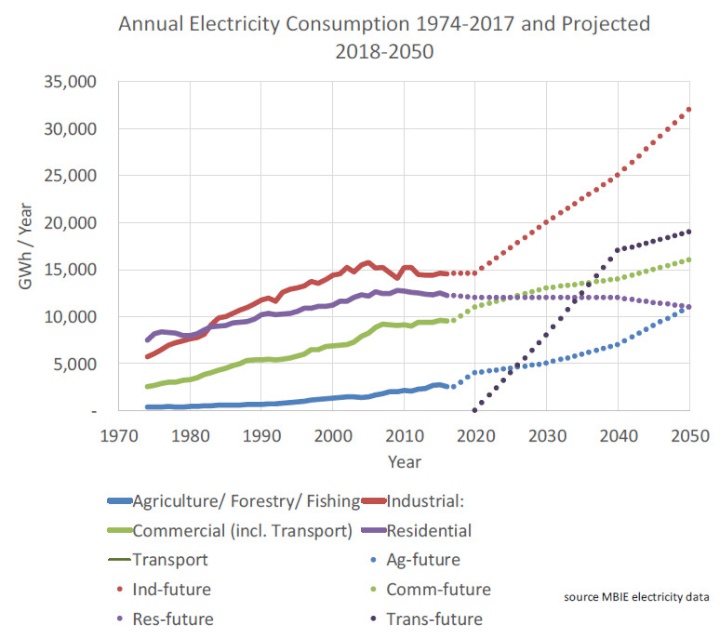Think Big electricity?
Press release: 25 September 2018
Think Big electricity? Or two hands clapping, everybody dancing
The Electricity Price Review is tied to a Think Big energy strategy paid for by consumers instead of taxpayers.
Their report envisages a massive increase in power generation. It does not consider a combination of rooftop solar, home wood burning, and home energy efficiency retrofits.
Solar rooftops are increasing rapidly. But they cannot meet New Zealand’s zero-carbon goal on their own. By itself solar is one hand clapping.
Clean wood burners offer exactly the winter peak energy needed to complement solar. With both, we could have a true 100% renewable energy economy for New Zealand.
The cheapest way to make more electricity available is a big increase in investment in energy efficiency. That strategy offers warm dry houses for everyone. That’s two hands clapping and everybody dancing!
Government wants to achieve low- (not zero-) carbon by doubling the amount of electricity we generate today. This would require many new giant wind farms, plus several new geothermal stations (which are not carbon-zero), plus at least seven more peaking power stations using gas. Their scenarios do not include expanding energy efficiency retrofits.
Theirs is a true Think Big strategy. Think Big was Prime Minister Muldoon’s plan to stimulate economic growth by building new power stations and chemical industries to use Maui Gas. The estimated cost to taxpayers was $7 billion. [https://www.nzherald.co.nz/nz/news/article.cfm?c_id=1&objectid=10703096]
The new power stations would be funded by consumers. Excess profits from the wholesale spot market delivered $5.4 billion to the big corporate power companies between 2010 and 2016 [https://cdn.auckland.ac.nz/assets/business/about/our-research/research-institutes-and-centres/energycentre/reports/Market%20Power%20in%20the%20NZ%20wholesale%20market%202010-2016.pdf]. This made it easy to build three big geothermal power plants and three wind farms. A new gas-fired peaking station is now under construction.
A strategy based on local energy would be far more cost-effective. Householders could provide much of their own energy - solar water heat as well as solar electricity. Wood burners could meet peak loads and even provide dry-year energy.
Air quality regulations now suppress home wood burning, and even require approved wood burners to be thrown away after 15 years. They are being replaced by heat pumps which add to peak electricity loads – which must be supplied by gas-fired peaking power stations.
Smog from wood burners has far lower health impact in New Zealand than the cold houses driven by high power prices. Hospitalisations in Christchurch are more closely tied to cold days than to measured air quality.
Truly clean wood burners are being developed in New Zealand, with smoke emissions a tiny fraction of those from “approved” wood burners. They can burn poorly seasoned wood cleanly; one can run on green wood alone. They could therefore provide dry-year energy.
An urgent priority is to commercialise these technologies.- but they cannot even be tested under today’s air quality regulations. Instead, New Zealand could simply adopt European standards.
However we should begin with the mantra promoted by the European Parliament’s energy and low-emissions policy - Energy Efficiency First.
The Electricity Price Review must not restrict itself to the official Think Big scenarios, and cannot pretend that the power stations would somehow pay for themselves. Consumers will pay for them so long as local energy and energy efficiency continue to be suppressed.



 Gordon Campbell: On Why We Can’t Survive Two More Years Of This
Gordon Campbell: On Why We Can’t Survive Two More Years Of This NZTA: Forecast Strong Winds For Auckland Harbour Bridge Traffic
NZTA: Forecast Strong Winds For Auckland Harbour Bridge Traffic Queenstown Lakes District Council: Top 10 Most Hazardous Items Found In QLDC’s Waste Facilities And Rubbish And Recycling Bins In 2024
Queenstown Lakes District Council: Top 10 Most Hazardous Items Found In QLDC’s Waste Facilities And Rubbish And Recycling Bins In 2024 NZ Government: Drive Safely This Summer
NZ Government: Drive Safely This Summer Northland Inc: Game-Changing Investment For Northland - Resilience Fund Allocates $250,000 To Health Simulation & Training Centre
Northland Inc: Game-Changing Investment For Northland - Resilience Fund Allocates $250,000 To Health Simulation & Training Centre Interchurch Bioethics Council: Church Bioethics Agencies Express Dismay at the Rushed Consultation Period for Submissions on the Gene Technology Bill
Interchurch Bioethics Council: Church Bioethics Agencies Express Dismay at the Rushed Consultation Period for Submissions on the Gene Technology Bill New Zealand Police: More Than $2.5m Worth Of Assets Restrained In Undeclared Tobacco Case
New Zealand Police: More Than $2.5m Worth Of Assets Restrained In Undeclared Tobacco Case


